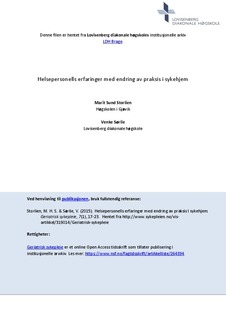| dc.contributor.author | Storlien, Marit Sund | |
| dc.contributor.author | Sørlie, Venke | |
| dc.coverage.spatial | Norway | nb_NO |
| dc.date.accessioned | 2016-10-11T10:39:04Z | |
| dc.date.available | 2016-10-11T10:39:04Z | |
| dc.date.issued | 2015-04-28 | |
| dc.identifier.citation | Storlien, M. H. S. & Sørlie, V. (2015). Helsepersonells erfaringer med endring av praksis I sykehjem. Geriatrisk sykepleie, 7(1), 17-23. Hentet fra http://www.sykepleien.no/vis-artikkel/319014/Geriatrisk-sykepleie | nb_NO |
| dc.identifier.issn | 1891-1889 | |
| dc.identifier.uri | http://hdl.handle.net/11250/2414166 | |
| dc.description.abstract | Bakgrunn: Forskning på kvalitet i norske sykehjem viser at tross kompetansehevende tiltak gjennom flere år, møter endringsprosesser i sykehjem motstand. Det etterlyses systematiske
utviklingsprogram for å bedre personalets ferdigheter. «Innføring av strukturert miljøbehandling i demensomsorgen », er et eksempel på dette. Utviklingsprosjektet er en del av et større utviklingsprogram i regi av Demensplan 2015 og ble gjennomført ved to sykehjem i Øst-Norge. Holdninger hos personalet er sentrale. Det blir satt fokus på hvordan helsepersonell arbeider sammen med pasientene.
Hensikt: Hensikten var å utvikle og innføre en metode for strukturert og individuelt tilpasset miljøbehandling.
Metode: Data om personalets erfaringer ble samlet ved fokusgruppeintervju med personalet som deltok i utviklingsprosjektet og analysert etter fenomenologisk hermeneutisk metode.
Funn: Ledelsens deltakelse, personalets reelle medvirkning og arena for refleksjon var sentrale komponenter for å lykkes med innføring av miljøbehandling i sykehjem.
Konklusjon: Forhold som påvirker personalets engasjement er av stor betydning for om endringsprosesser i sykehjem lykkes.
Nøkkelord: Helsefagarbeidere, sykehjem, endring av praksis, miljøbehandling, erfaringer | nb_NO |
| dc.description.abstract | Background: Changing practice in long-term care seems to be difficult. Studies about quality of care in nursing homes conclude that there is a need of systematic programs to develop health care providers skills in environmental treatment. «Structural environmental treatment by dementia» is such a systematic program. Attitudes of the personnel are essential and the model’s focus is not just what to do, but emphasize how the health workers work together with the patients.
Aim: The aim of this study was to illuminate factors that encourage or restrain implementation of environmental treatment in nursing homes.
Method: The data was collected through focus group interviews with health care providers in two Norwegian nursing homes and analyzed by a phenomenological hermeneutic method.
Findings: Management support and interpersonal processes are of particular importance for implementation of «Structural environmental treatment by dementia» in nursing homes. Conditions that facilitate commitment in the staff are essential. An essential factor that encourage a changing practice is that the leaders pay a careful and explicit attention to the implementation process.
Conclusion: Conditions that facilitate work engagement affect introduction of new practice in nursing homes.
Key words: Health care providers, nursing homes, changing practice, nursing environment, experiences | nb_NO |
| dc.language.iso | nob | nb_NO |
| dc.publisher | Sykepleien | nb_NO |
| dc.rights | Attribution-NonCommercial-NoDerivatives 4.0 Internasjonal | * |
| dc.rights.uri | https://creativecommons.org/licenses/by-nc-nd/4.0/ | * |
| dc.subject | Demens | nb_NO |
| dc.subject | Sykehjem | nb_NO |
| dc.title | Helsepersonells erfaringer med endring av praksis i sykehjem | nb_NO |
| dc.type | Journal article | nb_NO |
| dc.type | Peer reviewed | nb_NO |
| dc.source.pagenumber | 17-23 | nb_NO |
| dc.source.volume | 7 | nb_NO |
| dc.source.journal | Geriatrisk sykepleie | nb_NO |
| dc.source.issue | 1 | nb_NO |
| dc.identifier.cristin | 1240040 | |

